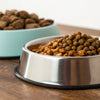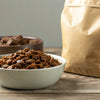How Much Dry Food for a 25 lb Dog: A Comprehensive Guide to Feeding Your Furry Friend
- Houndsy
Table of Contents
- Introduction
- Understanding Your Dog’s Nutritional Needs
- How Much Dry Food for a 25 lb Dog?
- Feeding Schedules: How Often Should You Feed Your Dog?
- The Role of Treats in Your Dog’s Diet
- Simplifying Feeding with the Houndsy Kibble Dispenser
- Conclusion
- FAQs
Introduction
Did you know that nearly 59% of dogs in the United States are classified as overweight or obese? This startling statistic underscores the importance of proper nutrition and portion control for our furry companions. As dog lovers, we understand that feeding our pets is about more than just filling a bowl; it’s about ensuring they lead a long, healthy, and happy life.
In this blog post, we will explore how much dry food is appropriate for a 25 lb dog, considering various factors that influence their dietary needs. By the end of this article, you will have a better understanding of how to determine the right amount of food for your dog, tailored to their unique lifestyle, age, and health status. We will also touch upon how our flagship product, the Houndsy Kibble Dispenser, can simplify the feeding process, ensuring your pet receives the right portions every time.
Let’s dive into the details of dog nutrition, feeding guidelines, and practical strategies for making mealtime a breeze.
Understanding Your Dog’s Nutritional Needs
When it comes to determining how much dry food a 25 lb dog should eat, several factors come into play:
1. Age
Puppies, adult dogs, and senior dogs all have different nutritional requirements. Puppies require more energy to support their rapid growth, while senior dogs often need fewer calories due to decreased activity levels. Here’s a brief overview:
- Puppies: Generally need 2-3 times the calorie intake of an adult dog for growth and energy.
- Adults: Typically require a consistent amount based on their weight and activity level.
- Seniors: Often need a lower-calorie diet as their metabolism slows down.
2. Activity Level
An active dog will require more calories compared to a couch potato. Consider your dog’s daily routine: Do they go for long walks, play fetch, or spend most of their day lounging?
- Highly Active Dogs: May need 30-50% more calories than less active dogs.
- Moderately Active Dogs: Should be fed based on the standard feeding guidelines.
- Sedentary Dogs: Require fewer calories to maintain their weight.
3. Body Condition Score (BCS)
The BCS is a visual and tactile assessment of your dog’s body fat. It helps determine if your dog is at an ideal weight, overweight, or underweight. Regular assessments can guide you in adjusting food quantities accordingly.
- Underweight Dogs: May need an increase in food quantity.
- Overweight Dogs: Should have their food intake reduced, possibly with the help of a veterinarian.
4. Health Status
Certain medical conditions require dietary adjustments. Dogs with specific health issues, such as diabetes or allergies, may necessitate special diets or controlled portions. Always consult your veterinarian for personalized feeding advice based on your dog's health.
How Much Dry Food for a 25 lb Dog?
Now that we’ve explored the factors influencing your dog’s dietary needs, let’s look at how to calculate the appropriate amount of dry food for a 25 lb dog.
General Feeding Guidelines
A good rule of thumb for adult dogs is to feed them 2-4% of their body weight in food daily. For a 25 lb dog, this translates to:
-
Daily Food Intake:
- 2% of body weight: 0.5 lbs (8 oz)
- 4% of body weight: 1 lb (16 oz)
This range provides flexibility, allowing you to adjust based on your dog’s specific needs, age, and activity level.
Example Calculation
If we take a moderate approach, let’s say our 25 lb dog is moderately active. We can start by calculating their daily caloric needs.
-
Estimate Caloric Requirements:
- For a 25 lb dog, a rough estimate is 25 x 30 + 70 = 820 calories/day. This is based on the equation for Resting Energy Requirements (RER).
-
Conversion to Food Amount:
- If the dry food contains approximately 400 calories per cup, your dog would need about 2 cups of food per day.
- This amount can be divided into two meals of 1 cup each.
Importance of Quality Food
Not all dog foods are created equal. The quality and caloric density of the food significantly impact how much to feed your dog. Always refer to the feeding guidelines on the dog food packaging, as they provide specific recommendations tailored to that product.
- High-quality brands may require smaller servings due to higher nutrient density.
- Lower-quality brands often necessitate larger servings to meet your dog’s nutritional needs.
Feeding Schedules: How Often Should You Feed Your Dog?
Feeding frequency is just as important as the amount of food. The general recommendation for adult dogs is to feed them twice a day, while puppies may require three to four meals. Here’s a breakdown:
-
Adult Dogs (like your 25 lb dog):
- 2 meals per day (morning and evening).
-
Puppies:
- 3-4 meals per day, gradually transitioning to fewer meals as they grow.
Benefits of a Regular Feeding Schedule
Establishing a consistent feeding schedule can help regulate your dog’s metabolism and prevent overeating. It also helps them understand when to expect meals, which can reduce anxiety and behavioral issues around food.
The Role of Treats in Your Dog’s Diet
Treats are an excellent way to reward your dog, but they should be included in their overall caloric intake.
- Treats should not exceed 10% of your dog's daily caloric intake.
- For a 25 lb dog, this means that if their daily caloric need is 820 calories, treats should not contribute more than 82 calories.
Incorporating Treats into the Feeding Routine
When using treats, consider adjusting the main meal portion to maintain a balanced diet. For example, if you provide a few treats throughout the day, slightly reduce your dog's main meal portions to compensate.
Simplifying Feeding with the Houndsy Kibble Dispenser
At Houndsy, we believe that mealtime should be convenient, consistent, and beautiful. Our flagship product, the Houndsy Kibble Dispenser, is designed to enhance the feeding experience for both pets and their owners.
- Perfect Portion Control: The dispenser allows you to serve the precise amount of food without the mess.
- Standing Height Crank: No more bending over to fill bowls! The ergonomic design makes feeding easy and enjoyable.
- Auto-locking Mechanism: Prevents accidental dispensing, ensuring that only the right amount of food is served.
Our commitment to quality and design excellence means that the Houndsy Kibble Dispenser not only functions flawlessly but also complements your modern home decor. Explore the Houndsy Kibble Dispenser here.
Conclusion
Feeding your 25 lb dog the right amount of dry food involves understanding their unique needs and making informed choices about their diet. By considering factors such as age, activity level, body condition, and health status, you can ensure that your furry friend receives the nutrition they need to thrive.
As we’ve discussed, establishing a consistent feeding routine and utilizing quality products like the Houndsy Kibble Dispenser can simplify the feeding process, making it a positive experience for both you and your pet.
Reflect on your own dog’s feeding habits: Are you confident you’re providing the right amount of food? If you have any doubts or need personalized advice, consulting your veterinarian is always a wise step.
FAQs
1. How do I know if I'm feeding my dog the right amount?
Check your dog’s body condition score and adjust their food intake based on their activity level and weight. Consult with your veterinarian for personalized recommendations.
2. Can I free-feed my dog?
Free-feeding can lead to overeating and obesity for many dogs. It’s generally better to establish a set feeding schedule.
3. What should I do if my dog is overweight?
Consult your veterinarian to create a tailored weight loss plan, which may include reducing food intake and increasing exercise.
4. How can I transition my dog to a new food?
Gradually mix the new food with the current food over a week or so, increasing the new food's proportion each day to prevent gastrointestinal upset.
5. Are there any foods I should avoid feeding my dog?
Yes, avoid foods that can be toxic to dogs, such as chocolate, grapes, onions, and garlic. Always check with your vet before introducing new foods.
By understanding your dog’s needs and utilizing effective feeding tools, you can enhance their feeding experience and ensure they live a happy, healthy life. Order your Houndsy Kibble Dispenser here and take the first step towards elevating your dog’s mealtime!












